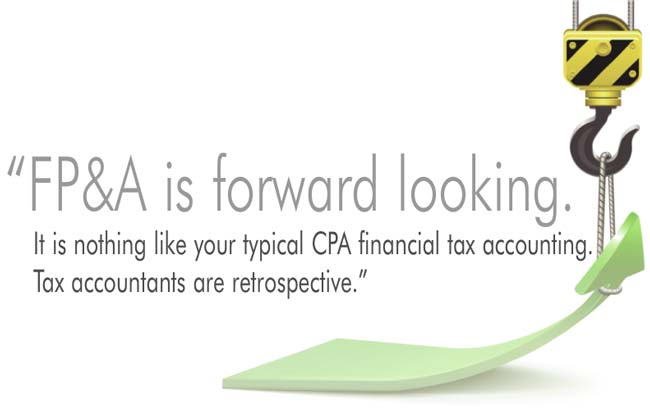I hope that you achieved all your goals in 2014 and produced a healthy cash flow from your operations. Congratulations if you have! Congratulations if you are truly satisfied with your results! However, if you want to do better in 2015 please read on.
I am writing this because I want to share with you a necessary practice that top performers do every year and maintain throughout the year: they conduct formal and professional financial planning and analysis (FP&A).
Top performing businesses analyze and plan because:
- It forces them to think strategically.
- It allows them to develop key tactics to achieve strategic goals.
- It helps them focus on the performance indicators that matter.
- It shows them the path that their entire organization must follow.
- It gives them a much higher chance of success than if they did not have a formal financial plan.
Financial planning and analysis has both quantitative and qualitative aspects.
FP&A is quantitative because it allows us to project the raw numbers (metrics) that need to be achieved to arrive at desired profit and cash flow levels. These metrics act as performance indicators during the course of everyday business. For example, to achieve a 10% net income, a certain combination of customer visits, average sale, close rate, cost of goods, gross margin, advertising spend, commission rates, and other operating outputs must be generated. Then, to produce a determined cash flow increase, an additional combination of product mix, return on investment, and asset and liability levels need to be maintained.

FP&A is qualitative because there are specific actions that need to be put on paper and then executed by managers and employees for the numbers to become reality. It is easy to “just say it”, but “just doing it” is what separates leaders and laggards.
For example, if a gross margin return on inventory (GMROI) overall of $2.50 is a target metric, tactics such as running a fast merchandise distribution system, a markdown that starts under 60 days, 95% best seller in stock days, and periodic category and vendor analysis may be required.
Everyone in your organization needs to be clear on what they are required to achieve. Every member of your organization needs to be clear on how to achieve it. That is what Financial Planning and Analysis puts in motion for you.
It is important that you understand that FP&A is forward-looking. It is nothing like your typical CPA financial tax accounting. Tax accountants are retrospective.
Creative Accounting is for the future not for the past: With financial planning, the past is only used to understand where you came from and how you are performing. FP&A paints a financial picture of where you could be if you properly execute the right tactics. It is a Pro forma. It allows you to start with the end in mind and consider various possible scenarios. Tax accounting is the necessary legal reporting when the end has already arrived.
How A Top-down FP&A System Works
1. Find out where your business is now from a financial and operational perspective. Review current systems procedures and outcomes.
2. Determine BIG PICTURE strategy with the ownership team. Define the FORWARD end-goal for profitability and cash flow.
3. Create a forward-looking financial statement model to arrive at your end-goal. Review past monthly sales data to understand seasonality. Determine if the end goal can be accomplished. Adjust the model until it is agreed upon.
4. Document key metrics that need to be achieved by organization team members.
5.Document specific actions and tactics that need to be executed.
6. Review and present performance standards to your department managers.
7. Organize any operational training that may be required.
8. Create a performance budgeted financial statement so your ownership team can see if they are on target at the end of each month.
9. Periodically review your plan and make adjustments to the tactics when and where necessary.
Should Your Accountant Do It?
It is very important that who you choose to assist you with Financial Planning and Analysis be qualified. This must be both top and bottom lined focus. This is big picture thinking with results that must be achieved at the ground level and the front lines of your operations.
Actually arriving at your destination, and the time it takes to get there, depends on your internal team and external partners working together.
Who does not qualify to conduct FP&A?
- An Accountant that specializes in tax reporting only. A good tax CPA is important to the operation but the skills and body of knowledge of tax and FP&A differ. Any organization requires both.
- An operational employee with no future financial modeling experience.
- Anyone who does not understand every aspect of your business and how they are integrated.
Who does qualify\to perform FP&A?
- A certified financial professional with forecasting and budgeting experience. For example, Certified Management Accountants (CMA’s) often specialize in FP&A in businesses.
- Someone who communicates well with the various organizational players – Owners, Managers, Employees, and external vendors and service providers.
- Someone who understands the industry segment you are in and how best practice operations perform.
- A person that has the qualities of being strategic, tactical, and also creative.
Plan right in 2015. The stakes are too high for your business to not plan at all. No plan is a perfect crystal ball but it is MUCH better than shooting in the dark. The FP&A process will prepare you and your team for the occurrences that will happen. You will get back on course faster than if you were without focus or measurement. Your odds of success will increase 100%, producing better profits and cash flow than if you ignored FP&A.